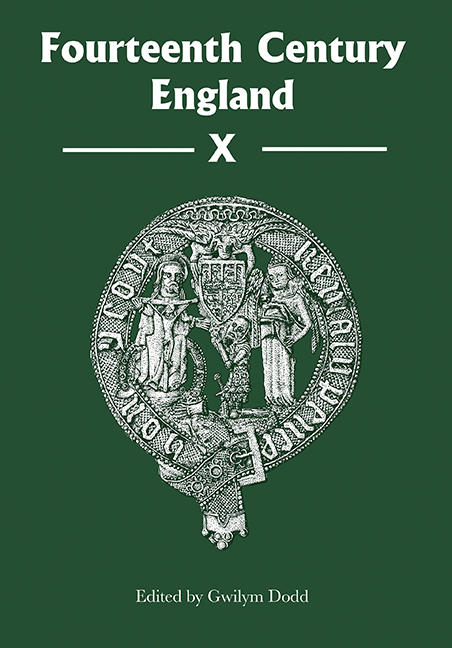Book contents
- Frontmatter
- Contents
- List of Illustrations
- Contributors
- Preface
- Abbreviations
- ‘Bought by the King Himself’: Edward II, His Chamber, His Family and His Interests in 1325–26
- Parliament in the Reign of Edward II
- The Representation of the Clergy in Parliament
- Feeding Mars: Military Purveyance in the Long Fourteenth Century
- ‘Unnatural in Body and a Villain in Soul’: Rape and Sexual Violence towards Girls under the Age of Canonical Consent in Late Medieval England
- Marriage and Inheritance: The Element of Chance in the Development of Lay Estates in the Fourteenth Century
- Mary Percy and John de Southeray: Wardship, Marriage and Divorce in Fourteenth-Century England
- Richard II's Kingship at St Stephen's Chapel, Westminster, 1377–99
- Bodies in Constant Motion: The Burials and Reburials of the Plantagenet Dynasty, c. 1272–1399
- Fourteenth Century England Issn 1471–3020
Marriage and Inheritance: The Element of Chance in the Development of Lay Estates in the Fourteenth Century
Published online by Cambridge University Press: 03 July 2019
- Frontmatter
- Contents
- List of Illustrations
- Contributors
- Preface
- Abbreviations
- ‘Bought by the King Himself’: Edward II, His Chamber, His Family and His Interests in 1325–26
- Parliament in the Reign of Edward II
- The Representation of the Clergy in Parliament
- Feeding Mars: Military Purveyance in the Long Fourteenth Century
- ‘Unnatural in Body and a Villain in Soul’: Rape and Sexual Violence towards Girls under the Age of Canonical Consent in Late Medieval England
- Marriage and Inheritance: The Element of Chance in the Development of Lay Estates in the Fourteenth Century
- Mary Percy and John de Southeray: Wardship, Marriage and Divorce in Fourteenth-Century England
- Richard II's Kingship at St Stephen's Chapel, Westminster, 1377–99
- Bodies in Constant Motion: The Burials and Reburials of the Plantagenet Dynasty, c. 1272–1399
- Fourteenth Century England Issn 1471–3020
Summary
It is well known that marriage was one of the most potent factors in the growth of individual late medieval lay estates, but it is perhaps less widely appreciated how often this was simply a matter of chance. Lands might be added to an estate through marriage in one of two ways. The first was marriage to a recognised heiress as a deliberate strategy of land accumulation. The second was an unexpected accrual which was the result of a marriage made when the bride was not expected to inherit. The distinction is one between marriage and inheritance and it is this distinction which is the subject of this essay. The discussion falls into three parts, the first establishing the circumstances under which a woman might inherit land, the second a statistical analysis of accruals of land by marriage contrasting marriage and inheritance, and last a discussion of the implications of the result.
The marriage of the heir was usually arranged by his father when he was in his teens, unless he had succeeded as a minor before his father had done so, in which case his marriage was at the disposal of the feudal overlord. For the father, the choice of a bride involved social and financial, and possibly political, considerations. The political aspect might have a specific motive, to make peace between families, but probably more often they were general, alliances between families of similar political leanings. A good example of this is the three marriages arranged by Bartholomew de Badlesmere in 1316 with leading members of the royal affinity, Roger Mortimer, William de Roos and Robert Fitzpayn. Whatever political considerations were involved, marriages were usually carried out between families of the same social standing and, for the marriage of the heir, this was the most important aspect and one which would be offset only by a large financial motive. The financial aspects of the alliance were usually encapsulated in the terms of the marriage contract. These might vary in detail according to the particular circumstances which pertained but almost invariably they included the size of the cash portion which would be paid by the bride's father to the groom's father and the size of the bride's jointure in lands which would be settled by the groom's father on the couple and their children.
- Type
- Chapter
- Information
- Fourteenth Century England , pp. 113 - 132Publisher: Boydell & BrewerPrint publication year: 2018

